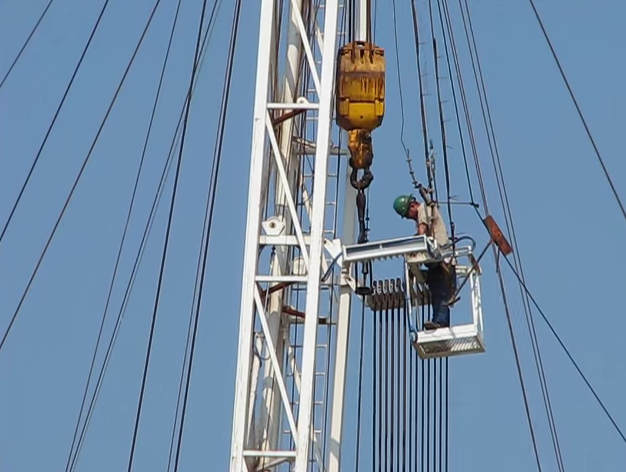Wrong safety line may have contributed to oil worker's death
Heather Richards 307-266-0592, Heather.Richards@trib.com
An improperly used safety cable may have contributed to the June death of an oil rig worker in Midwest, a Natrona County sheriff’s official said Thursday.
Details are still emerging about what happened when Dennis McCulloch, of Casper fell from a height between 74 and 78 feet, with official reports yet to be completed.
What is known is the 28-year-old derrick hand was on a workover rig in the Salt Creek Oil Field when he fell on the morning of June 14.
McCulloch was attached to a safety retention lanyard, according Sgt. Aaron Shatto of the Natrona County Sheriff’s Office.
However, the lanyard — a cable attached to an anchor to prevent falls — wasn’t properly used, Shatto said. The line attached to McCulloch was designed for vertical falls. In this case, the lanyard sustained significant side pressure, causing it to unravel and eventually break, according to the sheriff’s office records.
McCullough was seen standing on a platform on the side of the rig before the accident. Five other workers were on-site, either on the ground or on a lower level of the rig, when McCulloch fell.
He likely died upon impact, according to the Natrona County Coroner’s office.
Midwest Police Chief Jaimie Jones was the first law enforcement official on the scene. Jones was on his day off, but in the vicinity when McCulloch fell.
An investigation into the incident will likely be complete in a few weeks, said John Ysebaert, the Department of Workforce Services’ Standards and Compliance Administrator. Ysebaert oversees the state division of the Occupational Safety and Health Administration.
If the investigation finds that a company was at fault in McCulloch’s death, the firm will have the opportunity to protest any OSHA citations in an informal meeting with the regulators.
A company can submit additional evidence or plead for a reduction in the penalty amount based on its compliance history, preventive safety measures and the its size, Ysebaert said. Initial negotiations between OSHA representatives and the offending company are held behind closed doors.
McCullough was working for C L Well Service Inc. at the time of the incident. The oil field is operated by FDL Energy. The Texas-based company has launched a third-party investigation of the incident, part of its internal health and safety protocol, Ysebaert said. A wireline service company was also on site at the time of McCulloch’s fall. The company was collecting data from inside the well.
In oil and gas incidents, it is not unusual for multiple companies to be involved on a single work site, Ysebaert said.
C L Well Service has not had any safety violations since at least 2011, according to OSHA’s public records. A company representative could not be reached for comment Thursday.
Wyoming does not have the best reputation for workplace safety compared to other states.
Thirty-one people died on the job in 2014, the most recent state report available. Fourteen of those deaths were workers in the oil and gas industry.
To better understand Wyoming’s poor record, a number of factors should be considered, said Meredith Towle, the state occupational epidemiologist.
“In the federal system they are calculating rates, so it is the number of fatalities per employment. Wyoming has one of the lowest populations in the country, so our denominator is small, and our rate is higher,” Towle said. “Our industry mix is filled with very high risk jobs in mining, construction, transportation. That is part of the driving force too. We have a smaller workforce, but we also have a workforce that is heavily concentrated in high risk occupations.”
OSHA recently increased the maximum fine amounts for safety violations. Wyoming will adopt the 78 percent increase for maximum penalties next year. Current penalties were set in 1990s.
Safe work practices
All personnel can contribute to safe hoisting operations and help reduce the number of associated incidents and injuries.
Personnel must adhere to the following safe work practices:
Never “ride the load”; use only platforms specifically designed for personnel lifting.
Always use tag lines, unless their use would create an unsafe situation.
Keep all body parts inside the platform during raising, lowering, and positioning.
Secure the platform to the structure where the work is performed, unless securing it to the structure creates an unsafe situation.
Wear a harness system with a lanyard. The lanyard must be attached to the lower load block or overhaul ball or to a structural member within the personnel platform. If the hoisting operation is performed over water,
the employee must wear a U.S. Coast Guard-approved life jacket or buoyant work vest instead of a belt or harness, in accordance with OSHA 29 CFR 1926.106.
Working on the Mast - General Repairs
Drillers should not climb the mast to make repairs if the mast can
be lowered. If the mast cannot be lowered to make repairs, workers may use a ladder or may climb the mast if proper fall protection, such as a harness and attached lanyard, is available. Fall protection devices, in the form of a harness and lanyard, will be used where workers are 6 feet or greater in height (if a ladder or personal lift is not available). No one should climb the mast to ma
ke repairs while the drilling rig is operating.








